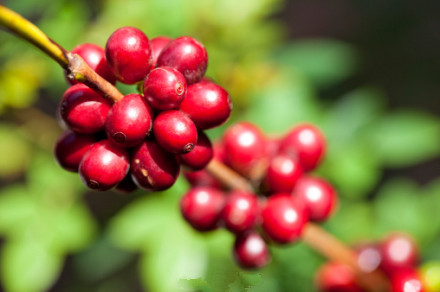Coffee tasting skills at home coffee common sense
Invite two friends to taste three kinds of coffee. Don't try to look for fundamental differences for the first taste, but consider identifying the main features, such as South American coffee or Asian coffee. For example, coffee in Ethiopia is high in acidity but light in weight, while coffee in Sumatran is low in acidity but full of grains.

You need three sets of cups (3 cups each-white, preferably medium) and a spittoon.
Grind a tablespoon of coffee for each reviewer, then put the powder into the bottom of the cup. Professional tasters can weigh coffee very accurately: some people weigh 10 grams of coffee on scales, while others like to weigh 12 grams. Write the name of the coffee on a piece of paper and put it under the cup. After grinding a kind of coffee, shake or brush the powder off the grinding tool as much as possible, and then start grinding the next kind of coffee. Professionals even grind a small portion of the lower group of coffee beans between the two groups to make sure no residue of the previous type is left. You should grind enough to set aside a small part of it on the plate or plate where the sample is defected.
The abrasive tools must be good and can work continuously. For the requirement that 0.2 to 0.6 mm coffee powder should account for 7% to 8%, either the cutting type or the airfoil coffee grinder is not ideal. The ground powder should be suitable for the drip, because only in this way can the fragrance be released at the best time. If the grinding is too fine, the fragrance will be released too quickly; if the grinding is too rough, the fragrance will be released insufficiently.
The amount of water required also needs to be accurately measured, because too much water makes the coffee thin, and too little water makes the coffee too dry. Take fresh cold water from the faucet, but let the faucet flow for a few seconds before filling the kettle. When the water is about to boil, pour it into the ground coffee. If there are 10 grams of coffee in the medium cup, the water should be added just to the edge of the cup. Make sure the heat of the water in each cup is the same and, if necessary, heat them close to the boiling point. If you live in a place where the water is hard, you need to boil the water before removing impurities, as these impurities may affect the taste of coffee. Some commentators prefer to fill the coffee in a coffee pot and pour it into the cup, but most of them pour water directly into their own cup to make the ground coffee.
Although the term for coffee tasting is "Cupping with porcelain cups", many commentators agree that transparent glasses are better so that they can take a closer look at the prepared coffee. If you decide to choose a glass, choose a glass that is wider at the top than the glass (the middle of the glass is wider than the top), because the wide cup is easy to taste the aroma of coffee.
Reviewers can first sniff freshly ground coffee, and then smell coffee in teacups or glasses that have been added to water. Do not stir the coffee at this stage, smell it again after 2-3 minutes, and smash the hard skin floating on the surface with a flat silver spoon (preferably a spoon). This is your first impression of coffee.
Remember to sniff twice, because our sense of smell disappears after 2 to 4 seconds, and this is how our bodies cope with new smells during the day. If you do not do so, the original smell will remain in consciousness and they will be mixed with the new smell. Some reviewers use one of these nostrils to smell, but a pause of a few seconds is enough to restore the sense of smell. Write down your first impressions of coffee: earthy, gray, botanical, floral, or something else. When you comment, you should try your best to keep the language accurate and describe it in professional words.
Repeat these steps for all the coffee you are tasting, and don't forget to rinse your spoon before tasting each coffee.
Next, gently stir the mixture, pick up a spoonful, suck it like in your mouth, and smash it to the ground instead of drinking water as usual. You may think that the appearance and sound of the drink is not elegant, it is true, but you are judging it, so there is no need to maintain etiquette or feel shy. To "chew" the coffee in your mouth, find out its acidity and fullness. Particles are a very important item-is this kind of coffee bean full of grains? Acidity is more difficult to determine, but you can taste it by your tongue. Spit out the coffee and write down your impression.
After the second taste, the point of view is different, and many people find tea and coffee more difficult to distinguish than wine. Because the alcohol in the wine lasts on the taste buds for a long time, it helps to identify it. Some commentators find it difficult to determine the boundaries between coffee and tea in just one or two tastes. So you may want to try to taste all the coffee and "chew" them to determine their granules and acidity, and then taste them, but this time it's even harder. This time you are looking for their own characteristics and taste, sweet or salty? Charcoal or mildew? To taste accurately, you must smash it as hard as you can, deliver the coffee to the back of the mouth and spray it on the soft upper jaw. You may make a lot of noise and be a mess, but you may also have fun. Don't forget to write down your feelings.
Important Notice :
前街咖啡 FrontStreet Coffee has moved to new addredd:
FrontStreet Coffee Address: 315,Donghua East Road,GuangZhou
Tel:020 38364473
- Prev

Coffee common sense the way people in various countries drink coffee
People all over the world drink coffee in different ways, but if you ask how many ways to drink coffee, I'm afraid no one can tell. It can be said that there are many ways to drink coffee in as many countries as there are in the world. 1/3 people in the world drink coffee, but it seems that no two countries drink coffee in the same way. People in Arab countries
- Next

What to do and what not to do when tasting coffee
(1) No milk is the most widely used coffee condiment. Traditionally, milk has never been added to coffee in some countries such as Yemen, Ethiopia and Turkey. It is widely believed that milk was first added to coffee by Monin in Grenoble in 1685. In the mid-1980s, 57% of people in the United States drank coffee with milk, while Germany had a high percentage.
Related
- Beginners will see the "Coffee pull flower" guide!
- What is the difference between ice blog purified milk and ordinary milk coffee?
- Why is the Philippines the largest producer of crops in Liberia?
- For coffee extraction, should the fine powder be retained?
- How does extracted espresso fill pressed powder? How much strength does it take to press the powder?
- How to make jasmine cold extract coffee? Is the jasmine + latte good?
- Will this little toy really make the coffee taste better? How does Lily Drip affect coffee extraction?
- Will the action of slapping the filter cup also affect coffee extraction?
- What's the difference between powder-to-water ratio and powder-to-liquid ratio?
- What is the Ethiopian local species? What does it have to do with Heirloom native species?

